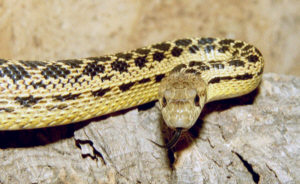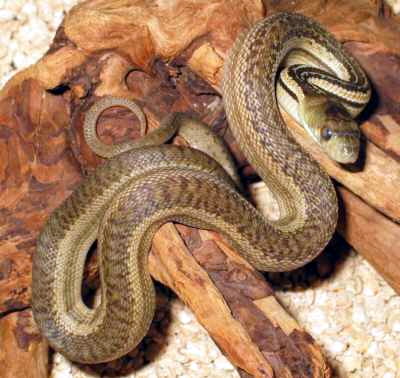|
last changes: Sunday, January 06, 2008
|
San Diego Gopher snake
Pituophis catenifer annectens
San Diegan Gophersnake
|
 |
|
Distribution |
|
You will find this snake in the southwest of the USA and in the north of Mexico.
Its distribution area starts in the southern California in the Santa Barbara County. Then you will find it at this up to the middle Baja California Norte in Mexico.
Its distribution area borders in the north on that of the subspecies catenifer. She reaches the subspecieses deserticola and affinis in the west and she reaches the subspecies bimaris in the south. In every contact regions there are smaller or also little greater intergrade areas.
|
|
Description |
|
This snake has a yellowish to deep brown primary color with a light gray sting at the side. In this color palette there are quite inconspicuous animals, different ones you will see in shining yellow or brick-red. She has 65-106 saddle spots on the body and 14-33 tail spots. At the side there are 3-4 one above the other lying rows of smaller and greater deep brown to black spots. The upper row runs exactly between the saddle spots, the once below runs again transposedly to this. In the nape of the neck the upper row of the side spots and the saddle spots go into each other, here are these spots black. Further in direction of the back middle the sides and saddle spots divide again and the saddles become more narrowly. The color of the spots changes usually into deep brown. In the back part of the snakebody the spots have become mostly narrow bar. The belly side, the tail and the throat are yellowly till orange. At each headside you will find a black stripe from the eye until the corner of mouth.
 |
There still is another pattern variant, the striped form. On this, the back and side spots are gathered to some or several more stripes which are going through. This variant could have resulted in cause of crossing the striped variant of the subspecies catenifer. (Briggs, 2001)
Complete length: until 2,2m but they seldomly approx over1,6m.
The scales are keeled. In the body middle there are at least 29 scale rows, mostly there are 31-33. Unusual features of head scale: 4 scales in front of eyes (Präfrontalia). The snout scale is approximately as broad as high (Rostrale - Nasale 1:1).
|
|
|
Habitat |
|
This gopher snake lives in various areas like deserts, half deserts, farm countrys, wine-growing areas, rivervalleys, pine woods up to mountain landscapes. It lives in heights between 0 m and max. 2000 m. The snake prefer lives in tunnels of rodent but it will use all other suitable shelters, too.
|
|
Way of life |
|
San Diegan Gopher snake is for the most part day active. If it gets too hot in summer during the day, it transfers the activity time on the evening and morning hours. Sometimes it scales trees and bushes on the search for bird's nests, otherwise it is ground living.
|
|
Diet |
|
In the habtat the snake eats mainly various rodents, birds and there eggs.
In addition, there were also named lizards and bats as natural food.
|
|
Hibernation |
|
This subspecies hibernates approximately October till March depending on weather, altitude, and distribution area. Within some years is the hibernation period quite briefly in cause of warm weather.
|
|
Reproduction |
|
Approximately from May until August the female lays 3-18 eggs at a suitable place. The eggs are approximately to 30 mm of x 90 mm. In the nature eggs have been seen in the time between May and September.
The San Diego gopher snakes haves a length at the hatch between 30 and 40 cm.
The coloring corresponds approximately to the parents animals. The primary color is usually mostly a little more palely and brightly, the back spots are a little darker than with the adult animals.
|
|
Keeping in terraria
|
|